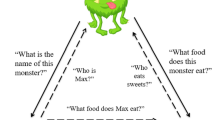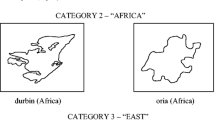Abstract
We tested the effect of multiple exemplar instruction (MEI) on acquisition of joint spelling responses, vocal to written and vice versa, for three sets of five words by four kindergarteners with language delays using a delayed multiple probe design. First, students were taught to spell Set 1 as either vocal or written responses (two vocal and two written) and probed on untaught responses. Next students were taught Set 2 using MEI (i.e., alternating responses) and again probed untaught responses for Set 1. Finally, Set 3 was taught in a single response and students were probed on untaught responses. Two students spelled none of Set 1 untaught responses before MEI, while two spelled the words at 60% accuracy or 10% accuracy. After MEI on Set 2, all students spelled untaught responses for Set 1 at 80% to 100% accuracy and Set 3 at 80% to 100% accuracy. The MEI resulted in joint stimulus function such that formerly independent responses came under the same stimulus control. We replicated these results with four other kindergartners with autism who performed academically above their typically developing peers. The results are discussed in terms of Skinner’s treatment of the independence of the two verbal operants.
Similar content being viewed by others
References
Albers, A., & Greer, R. D. (1991). Is the three term contingency trial a predictor of effective instruction? Journal of Behavioral Education, 1, 337–354.
Barnes-Holmes, D., Barnes-Holmes, Y., & Cullinan, V (2000). Relational frame theory and Skinner’s verbal behavior: A possible synthesis. The Behavior Analyst, 23, 69–84.
Becker, W. (1992). Direct instruction: A twenty-year review. In R. West & L. Hamerlynck, Design for educational excellence: The legacy ofB. F. Skinner (pp. 71–112). Longmont, CO: Sopris West.
Catania, A. C. (1998). Learning (4th Edition). Upper Saddle River, NJ: Prentice Hall.
Dougher, M, Perkins, D. R., Greenway, D., Koons, A., & Chiasson, C. (2002). Contextual control of equivalence-based transformation of functions. Journal of the Experimental Analysis of Behavior, 78, 63–93.
Emurian, H. H., Hu, X., Wang, J., & Durham, D. (2000). Learning JAVA: A programmed instruction approach using applets. Computers in Human Behavior, 16, 395–422.
Engelmann, S., & Carnine, D. (1982). Theory of instruction: Principles and applications. New York: Irvington.
Fields, L., Reeve, K. F., Mateneja, P., Varelas, A., Belanich, J., Fitzer, A., & Shannon, K. (2003). The formation of a generalized categorization repertoire: Effects of training with multiple domains, samples, and comparisons. Journal of the Experimental Analysis of Behavior, 78, 291–313.
Granzin, A. C, & Carnine, D. (1977). Child performance on discrimination tasks: Effects of amount of stimulus variation. Journal of Experimental Child Psychology, 24, 232–242.
Greer, R. D. (2002). Designing teaching strategies: An applied behavior analysis systems approach. New York: Academic Press.
Greer, R. D., & Keohane, D. (2004). The evolution of verbal behavior. Manuscript submitted for publication.
Greer, R. D., Keohane, D, Meincke, K, Gautreaux, G, Pereira, J., Chavez-Brown, M, & Yuan, L. (in press). Key instructional components of effective peer tutoring for tutors, tutees, and peer observers. In D. Moran and R. Malott (Eds.), Empirically Validated Educational Methods. New York: Elsevier.
Greer, R. D., & Lundquist, A. (1976). Discrimination of musical form through conceptual [general case operations] and nonconceptual successive approximation strategies. Bulletin of the Council for Research in Music Education, 47, 8–15.
Greer, R. D. & McCorkle, N. (2002). CABAS” international curriculum and inventory of repertoires from preschool through kindergarten. Yonkers, NY: CABAS and the Fred S. Keller School.
Greer, R. D., & McDonough, S. H. (1999). Is the learn-unit a fundamental measure of pedagogy? The Behavior Analyst, 21, 5–16.
Greer, R. D., & Ross, D. E. (in press). Verbal Behavior Analysis: A Program of Research in the Induction and Expansion of Complex Verbal behavior. Journal of Early and Intensive Behavioral Intervention.
Greer, R. D., Stolfi, L., Chavez-Brown, & Rivera-Valdez, C. (2004). The emergence of the listener to speaker component of naming in children as a function of multiple exemplar instruction. Manuscript submitted for publication.
Hayes, S. C, Barnes-Holmes, D., & Roche, B. (Eds.) (2001). Relational frame theory: A post-Skinnerian account of language and cognition. New York: Kluwer Academic/ Plenum.
Hayes, S. C, Fox, E., Gifford, E. V, & Wilson, K.G (2001). Derived relational responding as learned behavior. In S. C. Hayes, D. Barnes-Holmes & B. E. Roche (Eds.). Relational frame theory: A post-Skinnerian account of human language and cognition. New York: Kluwer Academic/ Plenum.
Horner, R. D., & Baer, D. M. (1978). Multiple-probe technique: Avariationonthe multiple baseline. Journal of Applied Behavior Analysis, 11, 189–196.
Ingham, P., & Greer, R. D. (1992). Changes in student and teacher responses in observed and generalized settings as a function of supervisor observations of teachers. Journal of Applied Behavior Analysis, 25, 153–164.
Lamarre, J., & Holland, J. G (1985). The functional independence of mands and tacts. Journal of the Experimental Analysis of Behavior, 43, 5–19.
Lamm, N., & Greer, R. D. (1991). A systematic replication of CABAS in Italy. Journal of Behavioral Education, 1(4), 427–444.
Lodhi, S., & Greer, R. D. (1989). The speaker as listener. Journal of the Experimental Analysis of Behavior, 51, 353–359.
Lowe, C. F., Home, P. J., Harris, D. S., & Rändle, V R. L. (2002). Naming and categorization in young children: Vocal tact training. Journal of the Experimental Analysis of Behavior, 78, 527–549.
Marsico, M. J. (1999). Textual stimulus control of independent math performance and generalization to reading. (Doctoral Dissertation, 1998, Columbia University) UMI Proquest Digital Dissertations [on line]. Dissertations Abstract Items: AAT 9970241.
Nuzzolo-Gomez, R., & Greer, R. D. (2004). Emergence of untaught mands or tacts of novel adjective-object pairs as a function of instructional history. Analysis of Verbal Behavior, 20, 63–76.
Porter, D., & Neuringer, A. (1985). Music discrimination by pigeons. Journal of Experimental Psychology: Animal Behavior Processes, 10, 138–148.
Ross, D. E., & Greer, R. D. (2003). Generalized imitation and the mand: Inducing first instances of functional speech in nonvocal children with autism. Journal of Research in Developmental Disabilities, 24, 58–74.
Skinner, B. F. (1957). Verbal behavior. Boston MA: Copley.
Selinski, J., Greer, R. D., & Lodhi, S. (1991). A functional analysis of the comprehensive application of behavior analysis to schooling. Journal of Applied Behavior Analysis, 24, 107–118.
Sprague, J. R., & Horner, R. H. (1984). The effects of single instance, multiple instance, and general case training on generalized vending machine use by moderately and severely handicapped students. Journal of Applied Behavior Analysis, 17, 273–278.
Stafford, M.W., Sundberg, M.L., & Braam, S.J. (1988). A preliminary investigation of the consequences that define the mand and the tact. The Analysis of Verbal Behavior, 6, 61–71.
Tsiouri, I., & Greer, R. D. (2003). Inducing vocal verbal behavior through rapid motor imitation responding in children with severe language delays. Journal of Behavioral Education., 12 (3), 185–206.
Twyman, J. (1996). The functional independence of impure mands and tacts of abstract stimulus properties. The Analysis of Verbal Behavior, 13, 1–19.
Williams, G, & Greer, R. D. (1993). A comparison of verbal behavior and linguistic curricula. Behaviorology, 1, 31–16.
Young, J. M, Krantz, P. J., McClannahan, L. E., & Poison, C. L. (1994). Generalized imitation and response class formation in children with autism. Journal of Applied BehaviorAnlysis, 27, 685–697.
Author information
Authors and Affiliations
Corresponding author
Additional information
We are grateful to Claire Eagan for her assistance in the collection of the data. In addition we are appreciative of the efforts of Regina Spilotras for her assistance in the reliable assessment of the instructional histories of each of the students. We are also indebted to Olive Healy and Yvonne and Dermot Barnes-Holmes for assisting us in our efforts to build more powerful scientifically based instruction. Finally, we are especially appreciative of the accurate, useful, and informative comments of the anonymous reviewers of this paper and the editor of The Analysis of Verbal Behavior.
Rights and permissions
About this article
Cite this article
Greer, R.D., Yaun, L. & Gautreaux, G. Novel Dictation and Intraverbal Responses as a Function of a Multiple Exemplar Instructional History. Analysis Verbal Behav 21, 99–116 (2005). https://doi.org/10.1007/BF03393012
Published:
Issue Date:
DOI: https://doi.org/10.1007/BF03393012




